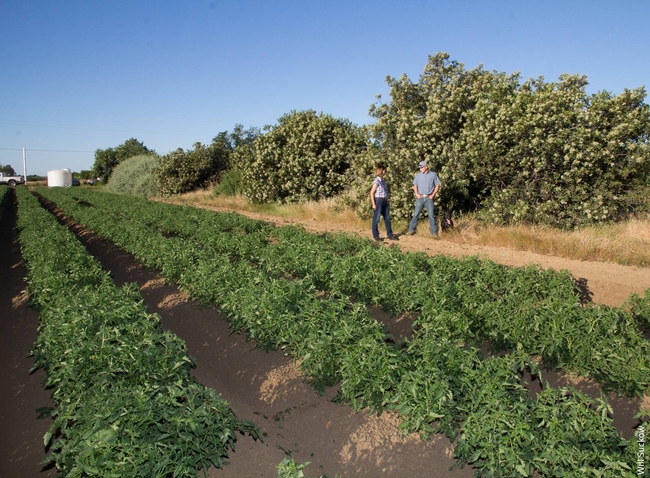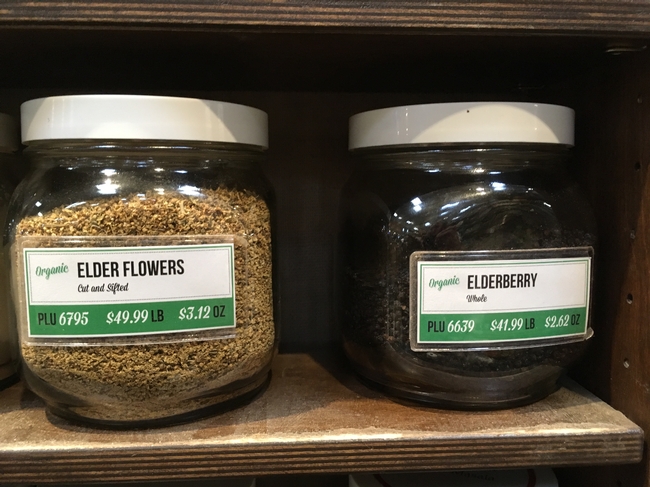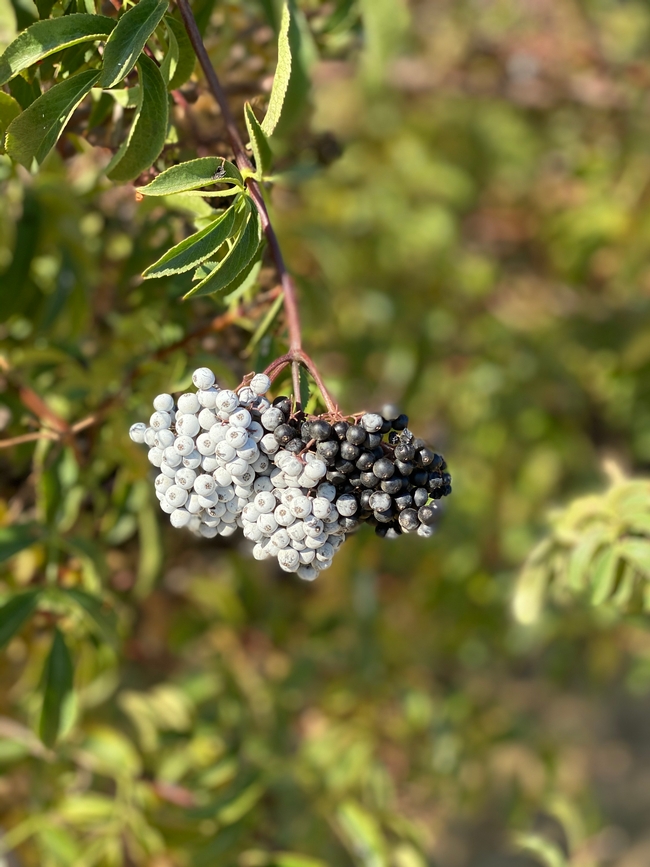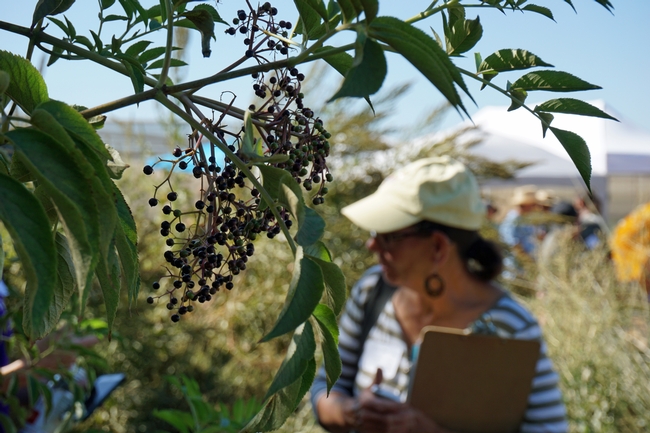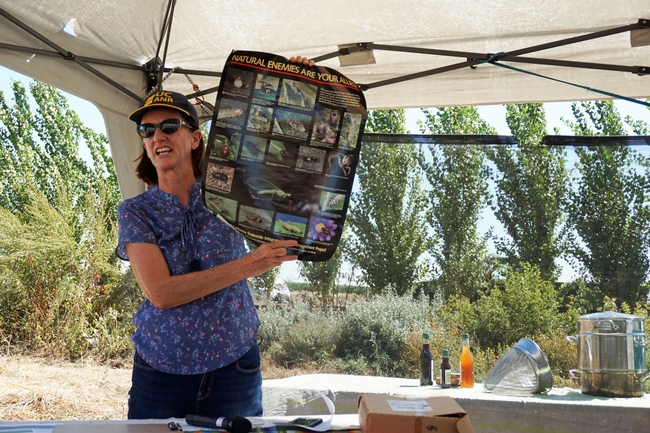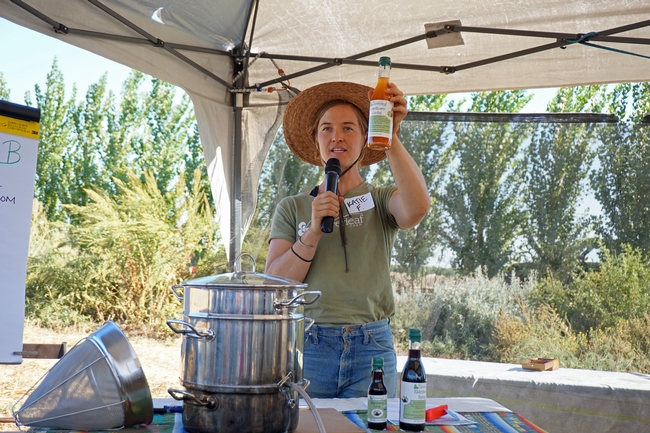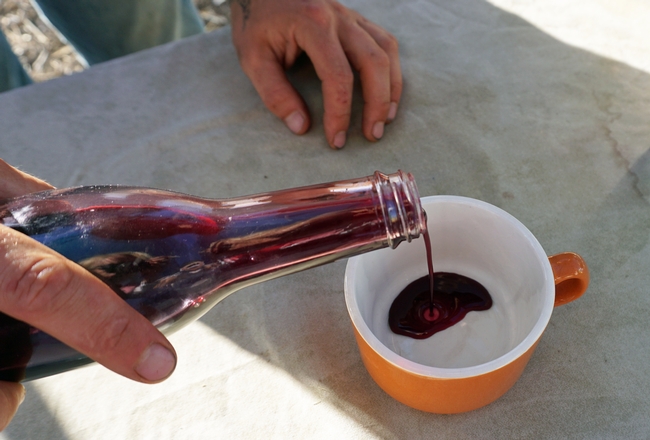Posts Tagged: elderberry
Growing elderberries in hedgerows adds to farm income, benefits environment
As the sustainability of agriculture continues to be threatened by changes in climate, pests and loss of biodiversity, the ancient practice of planting hedgerows with edible and medicinal species such as elderberry can help growers generate additional revenue while fostering beneficial insects and improving soil health.
Most modern-day farmland is occupied by simple “monocrop” systems that often require frequent, energy-intensive inputs like synthetic fertilizers and pesticides to sustain their yields. These practices can be harmful to water quality, biodiversity and soil health.
But farmers who incorporate perennials into their farm landscapes can better harness living things—crop plants, pollinators, beneficial microbes and natural enemies of pests—to provide services rather than adding synthetic products, to the ultimate benefit of the farm and the environment.
Restoring field edges by planting hedgerows is a common way to add perennials to farm fields without taking land out of production. These managed rows of trees, shrubs, grasses and wildflowers were an ancient feature of agricultural landscapes throughout the world.
As farmland industrialized in Europe and North America in the 1900s, many old hedgerows were removed. But hedgerows have seen a resurgence in recent years as their significant environmental benefits—including natural pest control and pollination services, improved soil health and carbon sequestration—are increasingly recognized.
With hedgerows, “the whole farm can be a site of both conservation and profitability,” says Sonja Brodt, deputy director of the University of California Sustainable Agriculture Research & Education Program (UC SAREP).
Hedgerows can be costly to establish, and this is often the reason farmers choose not to use them. But incorporating a harvestable crop into a hedgerow can be profitable.
Brodt is leading a collaborative effort with California farmers and UC researchers to develop native western elderberry as a hedgerow cash crop. Blue elderberry (Sambucus nigra ssp. cerulea) is a native subspecies of elderberry that is well-adapted to Mediterranean climates and grows prolifically across California. It is thought to be more heat- and drought-tolerant than the more commercialized North American and European subspecies of elderberry.
“Elderberries have this great potential as a ‘win-win' crop. Farmers harvesting and selling elderberries from their hedgerows can receive a direct income from a farm practice that benefits the local ecosystem,” says Brodt.
Consumer demand for elderberry-based products has skyrocketed in recent years. Blue elderberry has similar antioxidant levels to blueberries and can be processed into products such as jams, syrups, tea mixtures and herbal supplements.
“We found that two-thirds of surveyed herbal and specialty foods processors and retailers were strongly interested in sourcing California-grown elderberries and couldn't find enough supply to meet their needs” says Gwenaël Engelskirchen of UC SAREP. Farmers who grow blue elderberry can tap into this growing market.
The research team recently completed a field trial in the southern Sacramento Valley to assess the profitability of blue elderberry. They found that elderberry yields from a 1,000-foot, multispecies hedgerow could provide $2,700 to $4,800 in revenue, after harvest and de-stemming costs, in only the second year after hedgerow planting. This revenue helps offset typical hedgerow establishment costs of $3,000 to $4,000, and elderberry revenue is expected to grow over time as the plant yields continue to increase. Value-added processing and specialty products made on-farm could also increase overall profitability.
While native elderberry hedgerows is a new area of research for the University of California, North America's indigenous people have been harvesting and tending blue elderberry in California for hundreds of years. Many Native persons across the state continue to gather, cultivate and use elderberry.
Sage LaPena, Nomtipom and Tunai Wintu ethnobotanist and certified medical herbalist, stresses that “elderberry is one of our most important traditional medicines and we've never stopped using it.” Cultivating elderberry for harvest could be one path towards increased food sovereignty for California's Native American tribes.
“There's an important lesson with this work,” said Brodt. “While new technologies are valuable for making agriculture more sustainable, we shouldn't lose sight of ancient practices that have benefited humanity and our landscapes over thousands of years. Hedgerows and other biological solutions are an essential piece of the sustainability puzzle. In addition, we have much to learn about the value of our native species from Native peoples and their traditional practices.”
To learn more about this research and to find educational resources for cultivating, processing, and marketing elderberry, visit https://ucanr.edu/sites/Elderberry.
California elderberries have rich benefits for farms and diets
Native California elderberries can be found at the intersection of sustainable farming, super nutrition and economic viability. Naturally drought tolerant, flavorful and packed with nutrients, they are capturing the interest of farmers, health-conscious consumers and scientists.
Elderberries were the focus of a field day offered by UC Agriculture and Natural Resources Sustainable Agriculture Research and Education Program (SAREP) in September at Cloverleaf Farm, an organic berry and tree fruit operation in Dixon.
Elderberries occur naturally around the world. In California, Native Americans used the tree's stems for making flutes, berries for food and purple dye, and bark, leaves and flowers for their purported anti-inflammatory, diuretic and laxative properties.
“They had a relationship with the plant for food, medicine and music,” said SAREP academic coordinator Sonja Brodt. “We wish to honor the elderberry's history here and thousands of years of management by California native tribes.”
UC Cooperative Extension advisor Rachael Long said elderberries are her favorite native plant.
“They're pretty in the spring and summer. The flowers smell like cloves. It's a wonderful fragrance,” she said.
But perhaps the best attribute of elderberries for Long, a proponent of planting hedgerows on the edges of farmland, is the tree's ecological benefits. Elderberries can be among the rows of trees, shrubs, grasses and sedges in hedgerows that attract beneficial insects and pollinators to farms to help with biocontrol of pests and pollination of plants in adjacent crops.
“Flowering native plants like elderberries, toyon, Christmas berry, coffee berry, manzanita and coyote brush provide nectar and pollen for native bees, honey bees and other insects,” Long said. “I see a lot of green lace wings (predators of aphids, spider mites and other pests) in elderberry.”
Long reported that a tomato farm didn't have to spray as much for aphids because of the beneficial insects attracted by the hedgerow. “They saved $300 per acre each year,” she said.
Hedgerows require long-term planning and care, including weed control. Establishing a hedgerow costs about $4,000 for a 1,000-foot-long planting with a single row of shrubs and trees bordered by native perennial grasses. At that rate, Long has calculated that a return on investment in pest control takes about 15 years. For pollination, the return on investment is about 7 years.
Installation of hedgerows can be eligible for cost sharing with USDA's Natural Resources Conservation Service Environmental Quality Incentives Program. Costs can also be offset by harvesting the elderflowers and elderberries in the hedgerow and making value-added products – such as syrups and jams – or selling the flowers or berries to a processor.
Farmer Katie Fyhrie shared how Cloverleaf Farm is managing elderberries in a hedgerow, harvesting flowers in the spring to make and bottle elderflower cordial, and harvesting berries in the fall to produce and bottle deep purple sweet-tart syrup. Sixteen ounce bottles of cordial and syrup sell for $12 each. The cordial and syrup are ideal for serving with seltzer and ice for a fruity and uniquely wild-tasting drink.
Fyhrie is also working with Brodt of SAREP to gather data for research on best production practices, farm and processing labor costs, and yield comparison between native plants and named varieties from the Midwest. The study includes data from three California farms.
The project is a collaboration among the UC Sustainable Agriculture Research and Education Program (a program of the Agricultural Sustainability Institute at UC Davis), the UC Agricultural Issues Center, the UC Davis Department of Food Science and Technology and four farmers to assess the farm management practices, cost, nutritional content, and market potential of California elderberries.
While laboratory research comparing the nutritional characteristics of the California blue elderberry with the North American black and the European black is continuing at UC Davis, food science professor Alyson Mitchell and her graduate student Katie Uhl were able to share what is already known about the nutritional benefits of the fruit.
They said elderberries are high in vitamin C, dietary fiber, phenolic acids and anthocyanins. Elderberries contain antibacterial, antioxidant and anti-inflammatory agents. While they have a strong history as a treatment for colds and flu, more studies are needed to understand their medicinal use, Mitchell said.
The field day in Dixon was among the first outcomes of the two-year project. A growers' production guide, cost of production study, an assessment of market demand and nutritional analyses are also planned. The information will be made available, along with other resources on elderberry cultivation and processing, on the ASI website.


